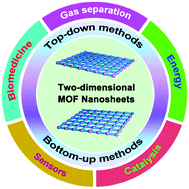Two-dimensional metal–organic framework nanosheets: synthesis and applications
Abstract
Two-dimensional (2D) metal–organic framework (MOF) nanosheets are attracting increasing research attention due to their unique properties originating from their ultrathin thickness, large surface area and high surface-to-volume atom ratios. Many great advances have been made in the synthesis and application of 2D MOF nanosheets over the past few years. In this review, we summarize the recent advances in the synthesis of 2D MOF nanosheets by using top-down methods, e.g. sonication exfoliation, mechanical exfoliation, Li-intercalation exfoliation and chemical exfoliation, and bottom-up methods, i.e. interfacial synthesis, three-layer synthesis, surfactant-assisted synthesis, modulated synthesis, and sonication synthesis. In addition, the recent progress in 2D MOF nanosheet-based nanocomposites is also briefly introduced. The potential applications of 2D MOF nanosheets in gas separation, energy conversion and storage, catalysis, sensors and biomedicine are discussed. Finally, we give our personal insights into the challenges and opportunities for the future research of 2D MOF nanosheets and their composites.

- This article is part of the themed collection: 2D nanomaterials: beyond graphene and transition metal dichalcogenides


 Please wait while we load your content...
Please wait while we load your content...